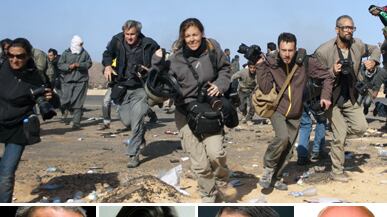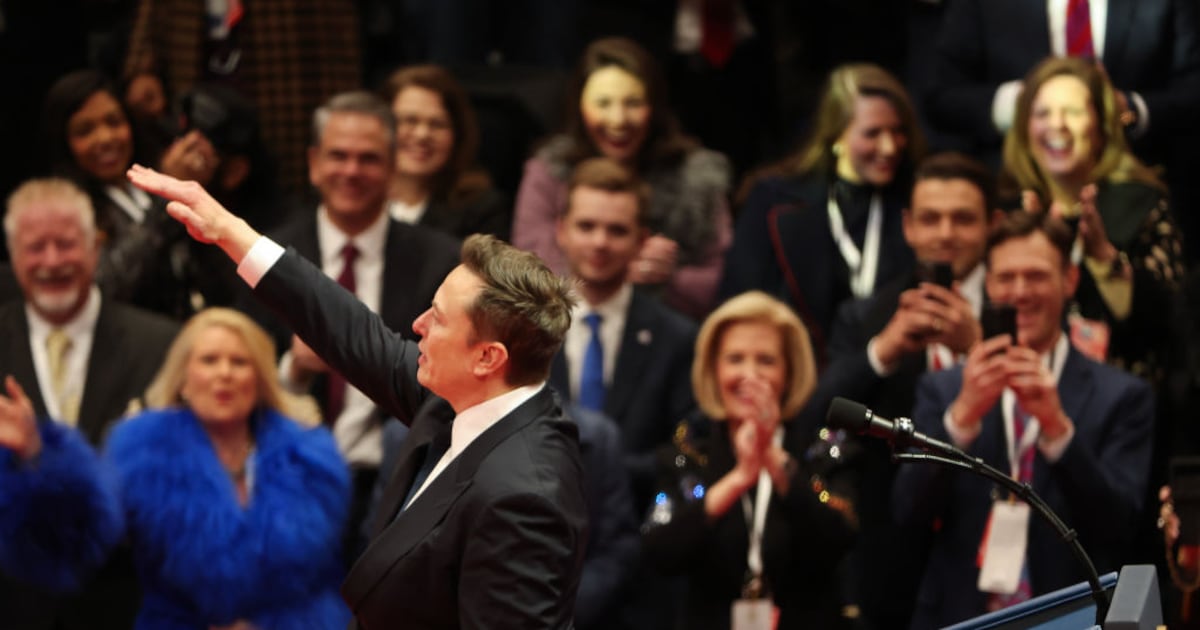Saif Gaddafi, the son of Muammar, tells ABC's Christiane Amanpour that the four New York Times journalists captured in Libya will be released. The journalists entered the country without visas, as is common, to cover the rebellion against Gaddafi. “They entered the country illegally and when the army, when they liberated the city of Ajdabiya from the terrorists and they found her, they arrest her because you know, foreigners in this place,” said Gaddafi. “But then they were happy because they found out she is American, not European. And thanks to that, she will be free tomorrow.” Gaddafi was seemingly referring to Lynsey Addario, a photographer, but Libyan officials confirmed that all four journalists would be released.Earlier this week, Babak Dehghanpisheh, a friend of the missing journalists, reported on the frightening situation and his last conversation with them. Plus, see photos and audio of captured journalist Lynsey Addario and full coverage of Libya.
A faint orange light illuminated the checkpoint on the pitch-black highway in eastern Libya last night. There was really nothing that signaled it was a checkpoint other than the young man wearing jeans and a hooded sweatshirt holding an AK-47. And he was insistently waving his left hand, signaling for us to stop. Was he a member of the Libyan opposition? Was he one of Muammar Gaddafi’s loyalists? It was impossible to determine: there were no flags, signs, or any other markings that would indicate who was running the show. But there was that AK-47, which made it a priority to listen to him. He peered inside the car suspiciously and asked the driver where we were headed.

“Tobruk,” the driver told him, a city near the Egyptian border. The young man backed off and waved us on. The driver flashed him a “V”—the sign of the opposition—and we both looked at each other with relief as we drove on.
I made the decision to take that risky drive from Benghazi to Tobruk last night because of the deteriorating security situation in eastern Libya. Gaddafi’s troops steamrolled into Ajdabiya, a city roughly 100 miles south of Benghazi, yesterday afternoon, and colleagues described scenes of utter chaos as civilians and rebel fighters hightailed it out of town.
There was a series of rushed discussions in the lobby of the hotel I was staying at in Benghazi, as journalists decided whether they should stay or leave.
Control of Ajdabiya not only gives Gaddafi’s fighters a close base to attack Benghazi, it also provides access to a desert highway straight to the Egyptian border, an easy way to cut off the rebels.
Lynsey Addario speaks on a panel (via telephone) at Newsweek and The Daily Beast’s Women in the World Summit in New York last week.
There was a series of rushed discussions in the lobby of the hotel I was staying at in Benghazi, as journalists decided whether they should stay or leave. Some were chain-smoking their way through the decision-making process; others were bouncing between calls on cell phones and SAT phones. As we talked, some journalists were already loading their bags in taxis. It was in the middle of this chaotic scene that a colleague told me something deeply worrying: a team of reporters and photographers from The New York Times who had been reporting in Ajdabiya had not checked in for a few hours. A short while ago, the editors of The New York Times confirmed this disheartening report.
The journalists—Anthony Shadid, Lynsey Addario, Tyler Hicks, and Stephen Farrell—are all good friends whom I’ve known for about 10 years. We rarely met in ordinary circumstances. We saw each other at Friday prayers in Sadr City in Baghdad or in the bombed-out suburbs of Beirut during the 2006 war between Hizbullah and Israel. But—I guess it’s part of the camaraderie of the job—the conversations always seemed to flow as if we’d seen each other just the day before even though we may not have seen each other for months. They are all the best at what they do, and the numerous awards they’ve piled up are a clear testament to their great work.
Gallery: Lynsey Addario on Assignment

Tyler and Lynsey were hunkered down at the front lines in eastern Libya producing amazing images long after many other journalists (including myself) found it too risky to work there. Ten days ago, I took a trip down to the front line at Ras Lanuf as the rebels were pushing ahead with great momentum. I drove into a chaotic scene on the edge of the town. A helicopter gunship was circling a checkpoint as a young rebel fighter blasted away with a heavy machine gun. Government jets thundered overhead and dropped a couple of bombs. The nearest shelter was a hotel in the residential portion of the Ras Lanuf oil complex, and I got there as quickly as I could. I walked into the lobby rattled and trying to compose myself when I saw Lynsey and Tyler sitting in a corner. They had arrived on the scene a couple of hours before, of course, shot what they needed, and were editing their images. It was hugs and high-fives all around when I went up to say hello, almost as if we were seeing each other at a café in Brooklyn, not the middle of a war zone. Tyler described some of that Ras Lanuf fighting in an interview for a New York Times blog.
I saw Lynsey again on Monday at the Ajdabiya hospital. This time she was with Anthony and Stephen. There had been a series of bombings in town that morning, and they were trying to determine if any casualties had been brought in. I talked to one doctor at the hospital who described an alarming development during the fighting in the town of Brega the day before. He was trying to recover a body from the street when a group of young men in plainclothes opened fired on him with AK-47s. It seems that these plainclothes Gaddafi loyalists also played a decisive role in the government attack on Ajdabiya yesterday afternoon. Residents of the town say these plainclothes militiamen opened fired on civilians and took control of key checkpoints around town. They may also be responsible for the attack that killed a cameraman for Al Jazeera on Saturday afternoon.
It’s clear that the conflict in Libya is becoming more dangerous and complicated each day. I made the decision to pull out to reassess the security situation this morning; a handful of other colleagues also left Benghazi today. The Times's post about the journalists cites secondhand reports that indicate they may have been picked up by Libyan government forces. From a safe distance away, I can only hope and pray that my friends are all right.
Babak Dehghanpisheh is NEWSWEEK's Beirut bureau chief. He's been covering the Middle East for the magazine since 2001.






